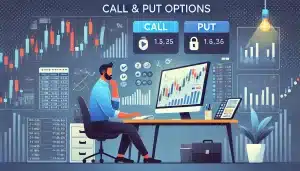Introduction to Options Trading
Introduction to Options Trading
Understanding The Basics of Options Trading

Options trading can be a powerful tool for investors looking to diversify their portfolios, hedge against risks, or capitalize on market movements. This article will introduce you to the basics of options trading, including what options are, how they work, and the key concepts and strategies you need to know to get started.
What Are Options?
Options are financial derivatives that give the buyer the right, but not the obligation, to buy or sell an underlying asset at a predetermined price within a specified time frame. The two main types of options are calls and puts.
Call Options
A call option gives the holder the right to buy an underlying asset at a specified price (known as the strike price) before the option expires. Investors purchase call options when they believe the price of the underlying asset will rise.
Put Options
A put option gives the holder the right to sell an underlying asset at a specified price before the option expires. Investors purchase put options when they believe the price of the underlying asset will fall.
How Do Options Work?
Options are traded on various exchanges, such as the Chicago Board Options Exchange (CBOE). Each option contract represents a standardized amount of the underlying asset, typically 100 shares.
Premium
The price paid for the option is called the premium. It is determined by several factors, including the underlying asset’s price, the option’s strike price, time until expiration, and market volatility.
Expiration Date
Options have a finite lifespan, ending on a specified expiration date. The value of the option is influenced by how much time remains until this date. As the expiration date approaches, the option’s time value decreases, a phenomenon known as time decay.
Key Concepts in Options Trading

Understanding some key concepts is essential for successful options trading. Here are a few important ones:
Intrinsic Value
The intrinsic value of an option is the difference between the underlying asset’s price and the option’s strike price. For a call option, it is the amount by which the asset’s price exceeds the strike price. For a put option, it is the amount by which the strike price exceeds the asset’s price.
Time Value
The time value of an option is the portion of the premium that exceeds the intrinsic value. It reflects the potential for the option to gain value before expiration. Time value decreases as the expiration date approaches.
In-the-Money, At-the-Money, and Out-of-the-Money
- In-the-Money (ITM): A call option is ITM if the underlying asset’s price is above the strike price. A put option is ITM if the underlying asset’s price is below the strike price.
- At-the-Money (ATM): An option is ATM if the underlying asset’s price is equal to the strike price.
- Out-of-the-Money (OTM): A call option is OTM if the underlying asset’s price is below the strike price. A put option is OTM if the underlying asset’s price is above the strike price.
Basic Options Trading Strategies
Several basic strategies can help you get started with options trading:
Buying Calls
Buying call options is a straightforward strategy where you purchase a call option when you expect the price of the underlying asset to rise. This allows you to potentially profit from the asset’s price increase without owning it outright.
Buying Puts
Buying put options is another simple strategy where you purchase a put option when you expect the price of the underlying asset to fall. This can help you profit from a decline in the asset’s price.
Covered Calls
A covered call strategy involves holding the underlying asset and selling a call option against it. This generates income from the option premium while potentially limiting the asset’s upside potential.
Protective Puts
A protective put strategy involves holding the underlying asset and buying a put option to protect against a decline in the asset’s price. This acts as an insurance policy, limiting potential losses.
Advanced Options Trading Strategies
Once you have mastered the basics, you may want to explore more advanced options trading strategies. These strategies can provide more flexibility and potential for profit but also require a deeper understanding of the market and risk management.
Straddles and Strangles
- Straddle: A straddle involves buying both a call and a put option with the same strike price and expiration date. This strategy profits from significant price movement in either direction.
- Strangle: A strangle is similar to a straddle but involves buying a call and a put option with different strike prices. It is a cheaper alternative to a straddle and profits from large price movements.
Spreads
Spreads involve buying and selling multiple options to limit risk and potential losses.
- Vertical Spread: A vertical spread involves buying and selling options of the same type (calls or puts) with different strike prices.
- Horizontal Spread: A horizontal spread involves buying and selling options of the same type with different expiration dates.
- Diagonal Spread: A diagonal spread combines elements of vertical and horizontal spreads by buying and selling options of the same type with different strike prices and expiration dates.
Iron Condors
An iron condor strategy involves selling an out-of-the-money call and put while simultaneously buying further out-of-the-money call and put options. This strategy profits from low volatility and aims to capture the premium from the sold options.
Risks and Considerations
Options trading carries risks and requires a good understanding of the market. Here are a few important considerations:
Leverage
Options provide leverage, allowing you to control a large position with a relatively small investment. While this can amplify gains, it can also magnify losses.
Volatility
Market volatility can significantly impact options prices. High volatility can increase premiums, while low volatility can decrease them.
Expiration
Options have a limited lifespan, and their value diminishes as the expiration date approaches. It’s essential to manage your positions carefully to avoid losing the entire premium.
Greeks
Options traders often use Greeks to measure different risk factors and potential changes in the option’s price. The primary Greeks are Delta, Gamma, Theta, Vega, and Rho.
- Delta: Measures the sensitivity of the option’s price to changes in the underlying asset’s price.
- Gamma: Measures the rate of change of Delta.
- Theta: Measures the time decay of the option’s price.
- Vega: Measures the sensitivity of the option’s price to changes in volatility.
- Rho: Measures the sensitivity of the option’s price to changes in interest rates.
Getting Started with Options Trading
To begin trading options, follow these steps:
- Educate Yourself: Learn about options trading through books, online courses, and webinars.
- Choose a Broker: Select a brokerage that offers options trading and provides the tools and resources you need.
- Open an Account: Open a trading account with your chosen broker and complete the necessary paperwork.
- Develop a Strategy: Create a trading plan that includes your goals, risk tolerance, and preferred strategies.
- Start Small: Begin with small positions to gain experience and confidence before committing larger amounts of capital.
Conclusion
Options trading offers a versatile and powerful way to participate in the financial markets, providing unique opportunities that are not available through traditional stock trading. By understanding the basics of options, key concepts, and fundamental strategies, you can begin to harness the potential of options to achieve your investment goals.
Understanding Options
The journey into options trading starts with grasping the fundamental concepts. Knowing what options are and how they work is essential. Options are contracts that give you the right, but not the obligation, to buy or sell an asset at a specific price within a certain timeframe. This flexibility allows traders to hedge against potential losses, speculate on future price movements, or generate additional income through various strategies.
Key Concepts and Terminology
Familiarize yourself with key terms like calls, puts, strike prices, premiums, intrinsic value, and time value. These terms form the foundation of your options trading knowledge. Understanding the difference between being “in-the-money,” “at-the-money,” and “out-of-the-money” helps in evaluating the potential profitability of an option.
Basic Strategies
Starting with basic strategies such as buying calls and puts can help you gain confidence. Buying calls allows you to profit from an increase in the asset’s price, while buying puts lets you profit from a decrease. These straightforward strategies are great for beginners because they limit your risk to the premium paid for the options.
Advanced Strategies
As you become more comfortable with the basics, exploring advanced strategies like straddles, strangles, spreads, and iron condors can offer more nuanced ways to trade. These strategies can help you manage risk, capitalize on market volatility, or take advantage of specific market conditions.
Risk Management
Effective risk management is crucial in options trading. The leverage provided by options can amplify both gains and losses. Therefore, understanding and managing risks through techniques like proper position sizing, setting stop-loss orders, and diversifying your portfolio is vital. The Greeks (Delta, Gamma, Theta, Vega, and Rho) are useful tools for measuring different aspects of risk and understanding how various factors affect your options positions.
Getting Started
To begin trading options, start by educating yourself through books, online courses, and webinars. Choose a reputable broker that offers a robust platform for options trading and provides the necessary tools and resources. Open a trading account, develop a solid trading strategy that aligns with your goals and risk tolerance, and start with small positions to build your confidence and experience.
Continuous Learning and Adaptation
The financial markets are dynamic, and continuous learning is essential. Keep yourself updated with market trends, news, and evolving strategies. Regularly review and refine your trading plan based on your experiences and changing market conditions.
Final Thoughts on Introduction to Options Trading
Options trading can be an exciting and rewarding endeavor if approached with the right knowledge and mindset. It offers opportunities to enhance your trading performance, hedge against potential losses, and achieve financial goals. However, it requires discipline, continuous learning, and effective risk management.
By starting with a solid understanding of the basics, practicing with small positions, and gradually exploring more advanced strategies, you can develop the skills and confidence needed to succeed in the dynamic world of options trading. Remember, the key to successful trading is not just making profits but also managing risks and protecting your capital. With dedication and the right approach, you can navigate the complexities of options trading and potentially achieve your investment goals.
If you want to learn more about our live trading rooms where we trade real money in real time, click here.
Happy Trading,
To Your success,

Billy Ribeiro is a renowned name in the world of financial trading, particularly for his exceptional skills in options day trading and swing trading. His unique ability to interpret price action has catapulted him to global fame, earning him the recognition of being one of the finest price action readers worldwide. His deep comprehension of the nuances of the market, coupled with his unparalleled trading acumen, are widely regarded as second to none.
Connect with us:





